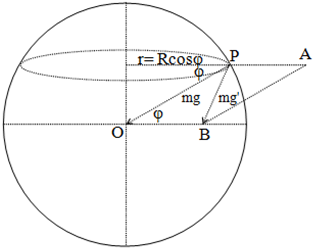
If earth were to spin faster, the acceleration due to gravity at the poles will:
(A) Increase
(B) Decrease
(C) Remains the same
(D) Cannot say
Answer
141k+ views
Hint If earth is spinning faster, this mean it has a higher angular velocity and thus a everyone on “off axis points” of earth will have a higher centrifugal force with respect to the axis of rotation of the earth
Complete step by step solution
When an object is placed on earth, it is constantly being pulled down due to gravity, this force is equal to mg. This is also the case when the earth is not rotating, if it was rotating then there would be another force which is also called the centrifugal force of the object. This force pushes the object from the surface of the earth and acts in the direction perpendicular to the axis of rotation of the earth. The net resultant of these 2 forces will give the apparent weight of the object

The resultant is thus given by,
\[g'\, = \,g - {\omega ^2}R\cos \phi \]
At the equator \[\phi \] is equal to 0 and at the poles, \[\phi \] is equal to 90 which makes the 2nd term as 0. Therefore the acceleration due to gravity at the poles is independent of the angular velocity of the earth.
So the correct answer is option C.
Note Note that the weight of the body is the force they exert in the surface of Earth. This is higher on poles and lower on other points.
If instead of pole, we need to take in consideration the gravity at the equator, it would be lower there. Also the angular velocity of earth under normal circumstances is \[7.29 \times {10^{ - 5}}\]
Complete step by step solution
When an object is placed on earth, it is constantly being pulled down due to gravity, this force is equal to mg. This is also the case when the earth is not rotating, if it was rotating then there would be another force which is also called the centrifugal force of the object. This force pushes the object from the surface of the earth and acts in the direction perpendicular to the axis of rotation of the earth. The net resultant of these 2 forces will give the apparent weight of the object

The resultant is thus given by,
\[g'\, = \,g - {\omega ^2}R\cos \phi \]
At the equator \[\phi \] is equal to 0 and at the poles, \[\phi \] is equal to 90 which makes the 2nd term as 0. Therefore the acceleration due to gravity at the poles is independent of the angular velocity of the earth.
So the correct answer is option C.
Note Note that the weight of the body is the force they exert in the surface of Earth. This is higher on poles and lower on other points.
If instead of pole, we need to take in consideration the gravity at the equator, it would be lower there. Also the angular velocity of earth under normal circumstances is \[7.29 \times {10^{ - 5}}\]
Recently Updated Pages
Difference Between Circuit Switching and Packet Switching

Difference Between Mass and Weight

JEE Main Participating Colleges 2024 - A Complete List of Top Colleges

JEE Main Maths Paper Pattern 2025 – Marking, Sections & Tips

Sign up for JEE Main 2025 Live Classes - Vedantu

JEE Main 2025 Helpline Numbers - Center Contact, Phone Number, Address

Trending doubts
JEE Main 2025 Session 2: Application Form (Out), Exam Dates (Released), Eligibility, & More

JEE Main Exam Marking Scheme: Detailed Breakdown of Marks and Negative Marking

JEE Main 2025: Derivation of Equation of Trajectory in Physics

Electric Field Due to Uniformly Charged Ring for JEE Main 2025 - Formula and Derivation

Learn About Angle Of Deviation In Prism: JEE Main Physics 2025

Degree of Dissociation and Its Formula With Solved Example for JEE

Other Pages
Units and Measurements Class 11 Notes: CBSE Physics Chapter 1

JEE Advanced Marks vs Ranks 2025: Understanding Category-wise Qualifying Marks and Previous Year Cut-offs

NCERT Solutions for Class 11 Physics Chapter 1 Units and Measurements

Motion in a Straight Line Class 11 Notes: CBSE Physics Chapter 2

Important Questions for CBSE Class 11 Physics Chapter 1 - Units and Measurement

NCERT Solutions for Class 11 Physics Chapter 2 Motion In A Straight Line




